Premise of Converged System Value
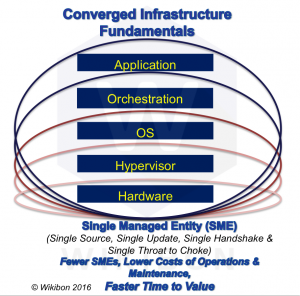
Source: © Wikibon 2016
Wikibon research consistently shows that delivering software-led infrastructure as a converged appliance significantly reduces enterprise IT costs. Wikibon has pointed out that over $300 billion dollars is spent worldwide by enterprise IT just to manage ongoing IT operations. This is undifferentiated work which does very little to improve application time-to-value or reduce IT costs, and is a drag on IT effectiveness. Wikibon has projected that two thirds of this low-value work will be eliminated from enterprise IT spend over the next 10 years, and move to IT vendor research and development of software.
Previous Wikibon research on converged infrastructure has focused on a specific application, such as VDI. But the principle is the same in a general purpose application environment. The fewer the independent elements in an appliance stack, the lower the costs and the faster the time-to-value. If all the elements in a converged application stack are procured, delivered and maintained from a lesser number of vendors (ideally one), the cost of deployment is significantly reduced. The time-to-value of initial software implementations is also significantly reduced, and upgrades delivered faster.
Wikibon has also shown that delivering a converged application appliance has the potential to reduce the number of elements, increase savings, and decrease time-to-value even further. Figure 1 applies the concept of creating Single Managed Entities (SMEs) to a System environment to reduce operational costs and duplicate public cloud deployment economics. The Wikibon definition of SME includes:-
- An integrated delivery of the solution as a single component;
- Regular singular, globally pretested updates to the solution;
- A single business partner for sales, deployment, maintenance and upgrades;
- A single hand to shake;
- A single throat to choke.
The Wikibon premise in this research is that this converged environment is a win-win environment for vendors, ISVs and enterprise IT. Testing of the converged system solution is more robust, and the reduction in the number of solution types significantly lowers testing and installation costs for the vendor. ISVs can lower the cost of deployment, deliver application value faster, and drive additional upgrade value much faster. Converged enterprise IT systems (private clouds) are more agile, more reliable, more secure and have the similar costs to public clouds.
Executive Summary of Case Study Analysis
Figure 2 below shows a summary of the results of the case study analysis between three approaches to providing a general purpose application infrastructure solution. The first column is a traditional cost-optimized white box approach using a modern VMware Server SAN approach with VSAN. The second column is a Lenovo/Nutanix converged infrastructure approach using VMware as the virtualization layer. The third column is a Lenovo/Nutanix converged infrastructure with Nutanix Acropolis as the virtualization layer. All the detailed assumptions are found in Table 3 in the footnotes.
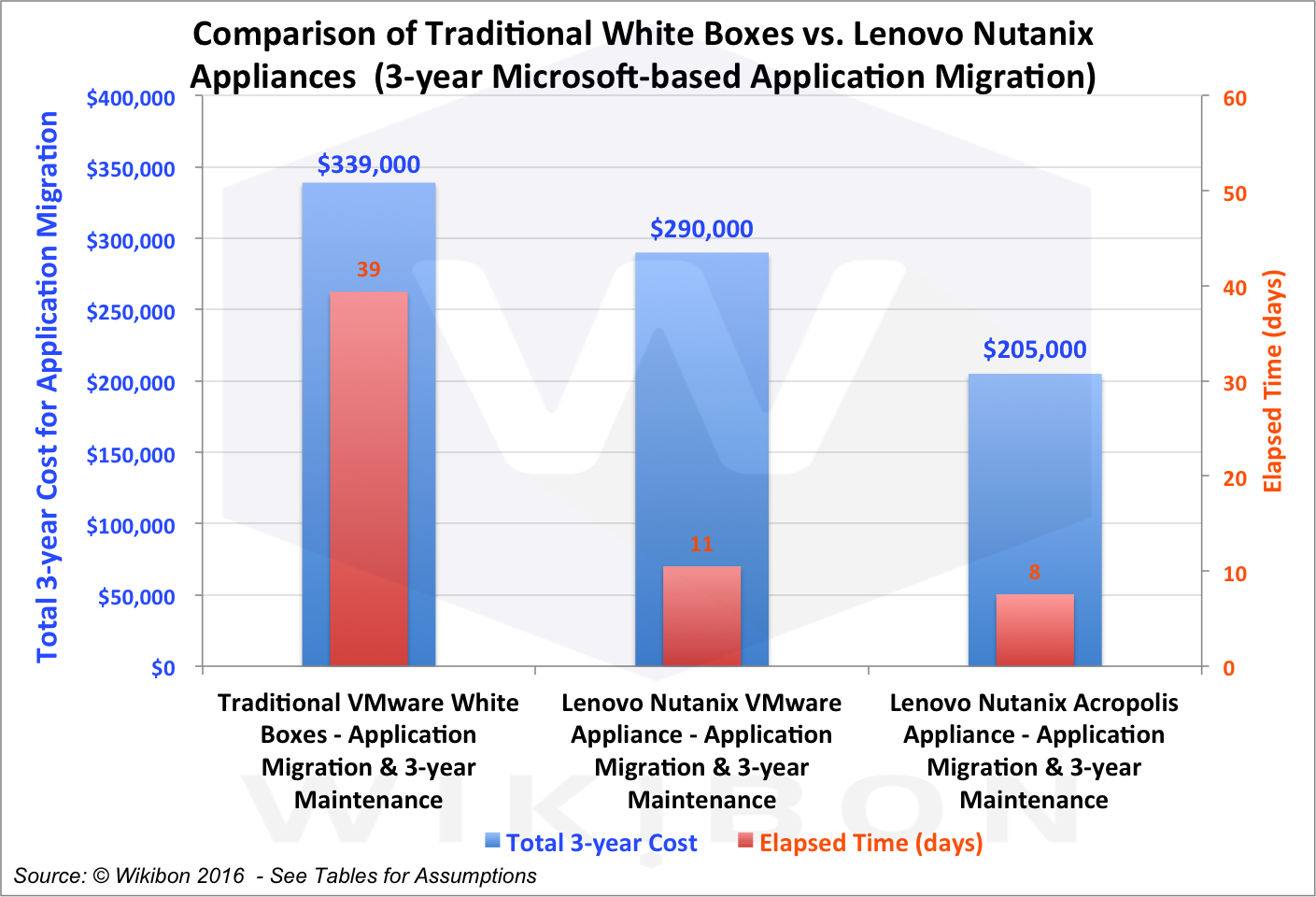
Source: © Wikibon 2016. See Table 3 in Footnotes for detailed assumptions.
The analysis shows that the best solution over three years is the Lenovo/Nutanix/Acropolis solution, with a total infrastructure cost of $205,000. The time-to-value of this solution was just 8 days. The financial analysis in the financial analysis section below shows that breakeven compared with the initial cost-optimized traditional VMware white boxes solution is 9 months, with a 3-year net present value (NPV) of $112,000 and an Internal Rate of Return (IRR) of 147%.
The second-best solution over three years is the Lenovo/Nutanix/VMware solution, with a total infrastructure cost of $290,000. The time-to-value of this solution was 11 days, longer than the Acropolis solution (8 days), but much shorter that the 39 days for the cost-optimized solution. The financial analysis in the financial analysis section below shows that breakeven compared with the initial cost-optimized traditional VMware white boxes solution is 24 months, with a 3-year net present value (NPV) of $73,000 and an Internal Rate of Return (IRR) of 53%.
However, the most important reason for deploying a converged appliance is the increase in agility, availability and quality of application that can be delivered to the business or organization. Enabling change to be made in hours/days compared with weeks/months enables IT to try different approaches and fail-fast or succeed. It means higher availability and faster time to deliver higher quality applications to the business.
The conclusions of this analysis are that converged infrastructure solutions are robust enough for general purpose deployment. Wikibon recommends that enterprise IT executives should focus on converged solutions where software and hardware vendors provide seamless highly-integrated solutions. Wikibon recommends that the Lenovo/Nutanix/Acropolis solution be included for analysis in any RFP for general purpose infrastructure.
Lenovo/Nutanix General Purpose Application Appliance
This research looks at a specific converged infrastructure system based on Lenovo hardware technology and Nutanix software technology. Lenovo is a fast growing global datacenter infrastructure provider focusing on Intel x86 architecture, storage and networking. Nutanix is the leading Server SAN and hyperconverged software vendor.
Lenovo has created a Nutanix-powered single SME converged general application appliance, using either a VMware hypervisor solution or a Nutanix Acropolis hypervisor solution. The Nutanix software significantly reduces the cost of the storage and cluster management. Each node can be added into a rack, and the cluster recognizes additional nodes automatically and enables the resources to be utilized for additional applications with no operational intervention. The Nutanix software also provides the automation and orchestration features to enable much faster application deployment. This significantly reduces the complexity and risk of development, deployment, and support of the total stack software, as well as reducing the time to install new deployments and upgrades compared with the traditional “best-of-breed” white-box approach. Solutions built on top of converged application appliances require fewer integration points and reduce the number of unique problems that complicate support for vendors and enterprise IT alike. Lenovo has put in place the global support and extensive testing of the solutions, acts as the single hand to shake, and is responsible for the whole stack up to (but not including) the application and middleware layers.
Case Study: Lenovo/Nutanix HX Series Appliance
This case study looks at applying a converged infrastructure solution to a mainly Microsoft application environment, with a mixture of middleware including Microsoft SQL Server and MySQL databases. The applications fall into three main categories:
- File & Print, Microsoft Exchange, Microsoft SharePoint, Active Directory, etc. This first phase is relatively simple to migrate to the Lenovo Nutanix environment, and is assumed to have less stringent availability and recoverability requirements than the second phase.
- Microsoft SQL Server Applications. The database applications are assumed to be the most mission critical applications. They require application consistent snapshots and backups, and the use of the microsoft VSS services within Nutanix Pro Edition. High availability and rapid recovery are assumed for the environment. The applications are migrated as the second part of the project, and Lenovo/Nutanix skills are increased and higher confidence is earned.
- Other Databases (mainly MySQL) & Applications. Other databases (mainly MySQL) and other applications supporting the core applications are migrated as the third phase of the project.
Each Lenovo HX Series node is an Intel x86 server with two E5-2600 processors, with 256GB of main memory, 800GB flash storage, and 6TB of hard disk storage. The Nutanix storage management and file system is part of the Nutanix software layer, and includes snapshots, replication, de-duplication and compression functionality. There is full integration of everything within each Lenovo Nutanix Appliance node, including the ability to cluster the original nodes and additional nodes automatically and seamlessly.
The comparison points in the study are:
- A cost-optimized hardware solution based on “White Boxes”
- A Lenovo/Nutanix HX 3500 with VMware-based Hypervisor1
- A Lenovo/Nutanix HX 3500 with a Nutanix Acropolis Hypervisor2
The general purpose File & Print, Microsoft Exchange and SharePoint applications are migrated to the Lenovo/Nutanix appliance in year 1, the SQL Server applications migrated in year 2, and the other databases and applications migrated in year 3.
All the detailed assumptions of the cost and time-to-value comparisons in Figure 2, Figure 3 and Figure 4 below can be found in Table 3 in the footnotes below.
Cost and Time-to-Value Results of Case Study Analysis
Figure 3 shows a breakout of the cost elements in Figure 2 above. The purple segment shows a dramatic reduction of operational support, from $134,000 over 3 years with the white box approach to $29,000 with the Lenovo/Nutanix/Acropolis converged solution.
VMware licensing includes VSAN for the white box solution, vSphere and vCenter for the white box and the Lenovo Nutanix VMware appliance, and no VMware cost for the Lenovo Nutanix Acropolis appliance. As Figure 3 shows, the 3-year VMware costs drop from $106,000 to $0 across the three solutions.
The red bars show the 3-year cost of the white boxes is much lower ($40,000) than the Lenovo/Nutanix Acropolis appliance ($159,000). The Nutanix software utilizes the Starter edition for the first three nodes in year one, and is upgraded to the Pro edition for the additional nodes in year two and year three. The most important additional feature in the professional edition was VSS support, required to provide application consistent snapshots for the database and other applications migrated over in years two and three. The Nutanix software is the key component in being able to reduce all the other support costs, and improve agility and time to value.
The last area of comparison is in the cost of set-up for the cost-optimized white boxes. Table 3 in the footnotes shows the hours taken for architecting, procuring, installing, configuring and documenting the white box solution is 255 hours. This is compared to just 67 hours for the Lenovo Nutanix VMware, and just 50 hours for the Acropolis solution.
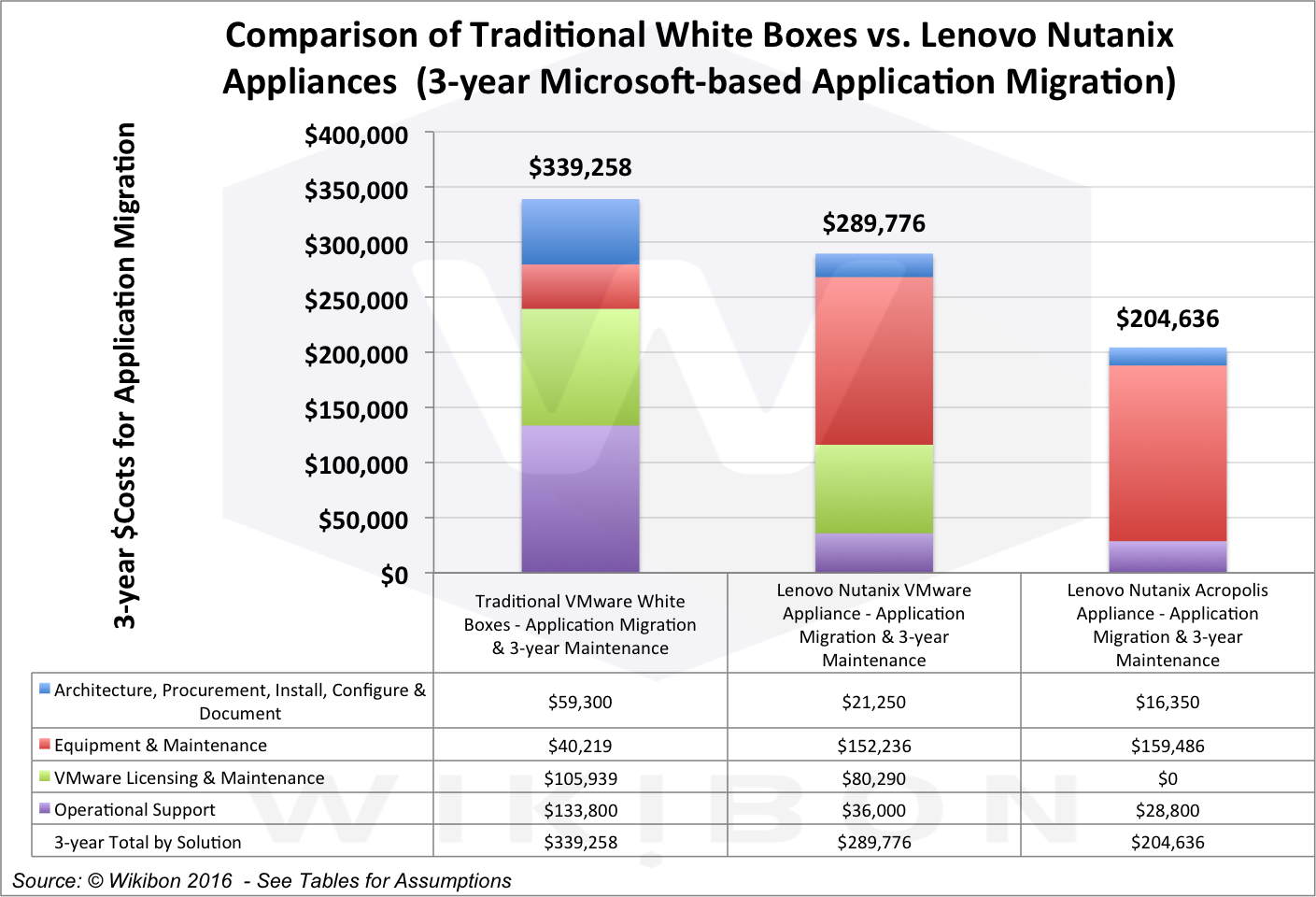
Source: © Wikibon 2016
See Table 3 in Footnotes for detailed assumptions
Overall, the number of people hours required to install and support the white box solution and upgrades is 1,375 hours over three years. The Lenovo/Nutanix solution takes 413 hours for the VMware version and 312 hours for the Acropolis version.
Figure 4 shows the days to complete the overall installation of the solution and upgrades, taking 39 days for the white box solution, and only 8 days for the Lenovo Nutanix Acropolis appliance. The time-to-value metric is the difference in elapsed time to complete the overall installation process, which is essentially serial. This does not take into account any problems in scheduling people. The difference is a quick installation with a single person for the Lenovo/Nutanix Appliances, compared to a much higher skilled team needed to implement a cost-optimized solution. Change is easy to implement, and shows up on the organizations balance sheet as more productive applications delivered earlier to the lines of business.
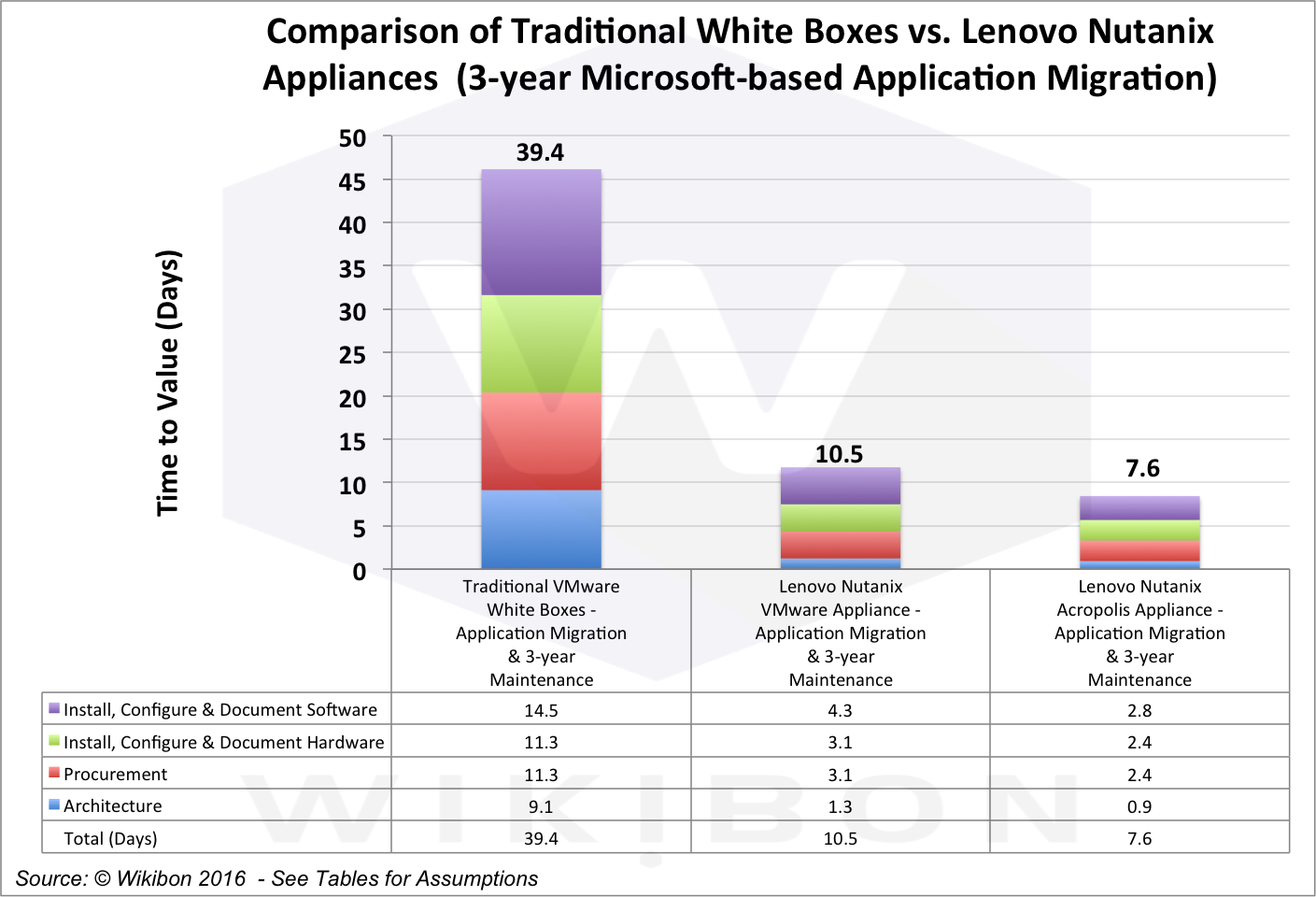
Source: © Wikibon 2016
See Table 3 in Footnotes for detailed assumptions
Case Study Business Case Analysis
Table 1 below shows the financial case between the white box solution and the Lenovo Nutanix Acropolis appliance. The additional investment required is about $25,000, and the return on this investment is about $150,000. The net total benefit is $124,000. When adjusted for the time value of money, the overall net present value (NPV) is about $112,000. The breakeven is 9 months, and the measure of financial return are well over any financial threshold (internal rate of return (IRR) is 147%).
However, the most important benefit not stated in the business case is the agility the Lenovo/Nutanix appliance gives IT to deliver change at a much higher pace to the business. Availability is higher. Infrastructure projects take hours or days, rather than weeks or months. New ideas can be tried out without risk, and succeed or fail-fast. This is the promise of public clouds, brought into a private cloud.
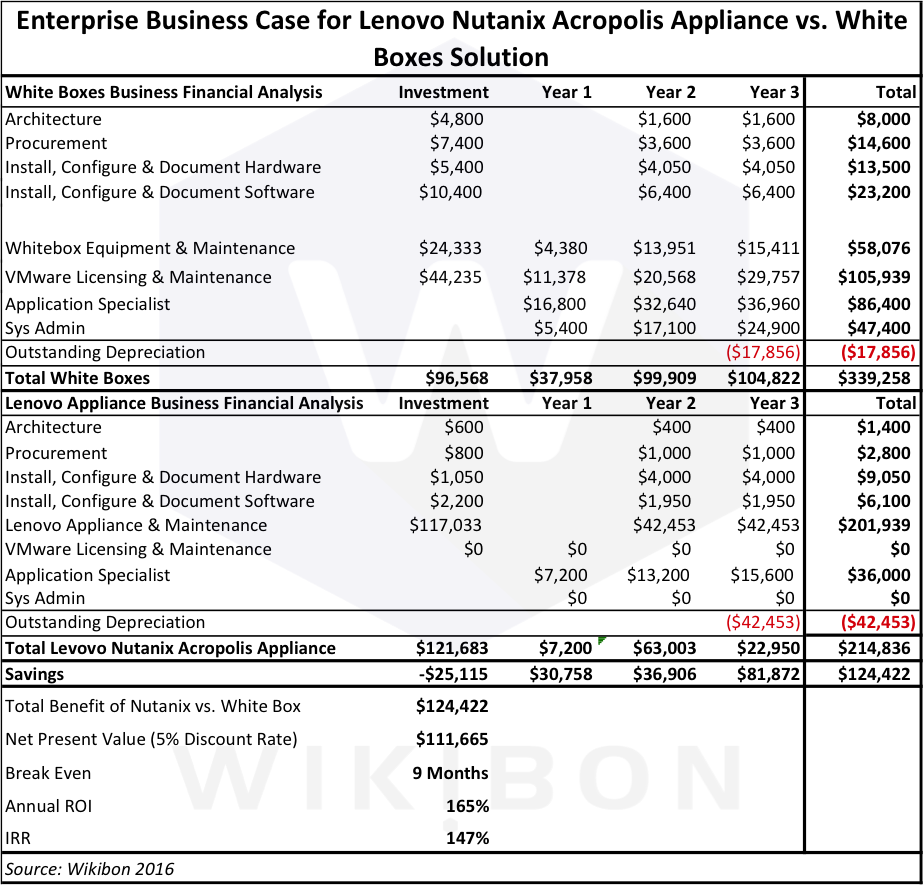
Source: © Wikibon 2016
See Table 3 in Footnotes for detailed assumptions
Table 2 below shows the business case for white box compared to the Lenovo Nutanix VMware appliance. Because of the additional VMware cost, the business case is not quite as strong, with a NPV of $73,000, a breakeven of 24 months and an IRR of 53%. However, when the benefits of a much more agile environment is factored in, as discussed earlier in this section, the overall business case is very strong indeed.
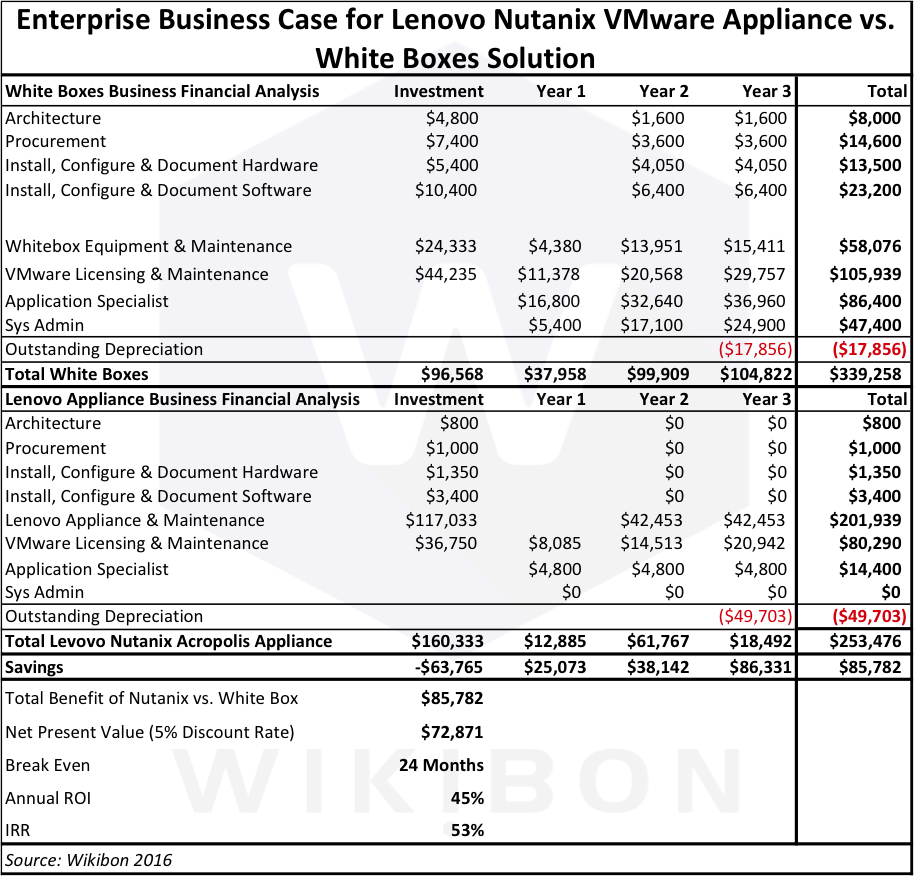
Source: © Wikibon 2016
See Table 3 in Footnotes for detailed assumptions
In summary, both Lenovo/Nutanix appliance solutions are cost effective against a cost-optimized white box approach. The main reasons for choosing an appliance is the infrastructure quality and agility it gives to the lines of business, and the ability to provide public cloud functionality in a private performant cloud.
Case Study Conclusions
The case study results support the Wikibon premise that this converged environment is a win-win environment for vendors, ISVs and enterprise IT. Most importantly, it is a win-win between IT and the lines of business, giving IT infrastructure far greater flexibility and agility to enable change, and deliver better applications faster to the organization.
The overall conclusions of this analysis is that converged infrastructure solutions are robust enough for general purpose deployment. Wikibon strongly recommends that converged infrastructure solutions (illustrated by this Lenovo/Nutanix case study) should be implemented as private cloud solutions instead of traditional cost-optimized infrastructure.
Action Item
Wikibon recommends that enterprise IT executives should implement software-led converged infrastructure solutions to achieve much higher levels of agility and reliability, and deliver better quality applications faster to the business. The key to success is to ensure that the software and hardware vendors provide a single solution, single updates, a single hand to shake and a single throat to choke. The layers and coordination to achieve this must be completely transparent. Wikibon recommends that a Lenovo/Nutanix solution be included for analysis in RFPs for general purpose infrastructure.
Footnotes
Note 1 The VMware virtualization options included consist of the free VMware vSphere Hypervisor; ESXi is the exclusive hypervisor for VMware vSphere 6.x licenses. vCenter provides scale-out clustering management support for multiple servers using vSphere. Virtual SAN (VSAN) is VMware’s shared storage software for creating a Server SAN architecture. This provides a much lower cost compared with a traditional storage array, and is the low cost way of providing and managing a shared storage scale-out environment. In the analysis, vSphere, vCenter and VSAN are deployed in the White Box solution, vSphere and vCenter are deployed in the Lenovo Nutanix VMware solution, and no VMware in the Lenovo Nutanix Acropolis hypervisor (AHV) solution (see Table 3 below for more details)
Note 2 The formal Nutanix product name for the Acropolis hypervisor Virtualization is AHV. AHV is based on the Open Source KVM product, and is a clustered low-overhead partitioner. The Prism management system sits above AHV to provide a single management console.
Table 3 below shows all the detailed assumptions behind Figure 2, Figure 3 and Figure 4 above, and Table 1 and Table 2 above. The initial investment of people time and equipment is included in investment, and applied in month 1 of the financial analysis in Table 1 and Table 2 above. The items in red are residual values of equipment and software purchased in years two and three. The residual items in red are applied as a credit in month 36 of the financial analysis in Table 1 and Table 2 above.
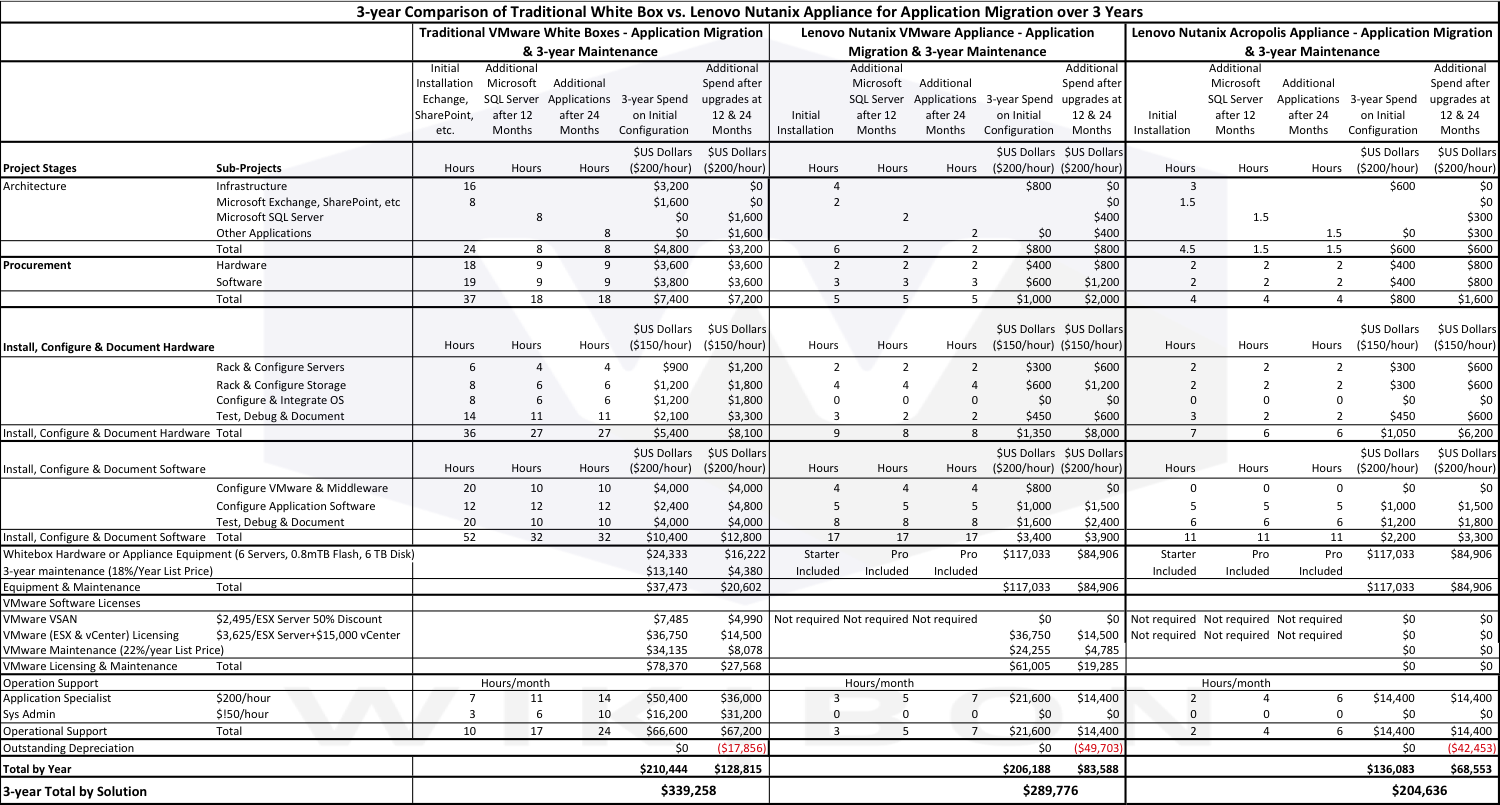
Source: © Wikibon 2016

